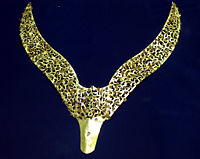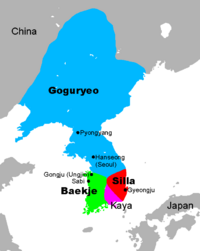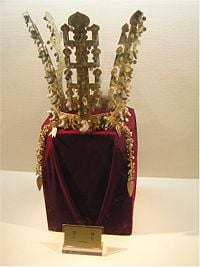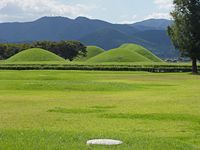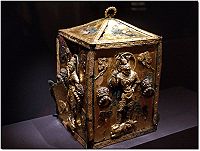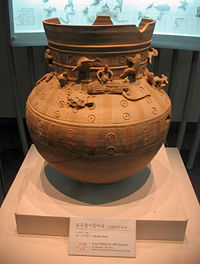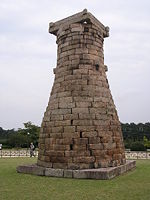Difference between revisions of "Silla" - New World Encyclopedia
Dan Davies (talk | contribs) (New page: {{claimed}} {{otheruses}} {{koreanname| image=200px|Seokguram| hangul=신라| hanja=新羅| rr=Silla | mr=Silla|}} {{History of Korea}} '''S...) |
({{Contracted}}) |
||
| Line 1: | Line 1: | ||
| − | {{claimed}} | + | {{claimed}}{{Contracted}} |
{{otheruses}} | {{otheruses}} | ||
Revision as of 17:38, 30 July 2007
- For other uses, see Silla (disambiguation).
| Silla | ||||||||
|---|---|---|---|---|---|---|---|---|
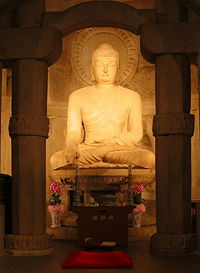 | ||||||||
| Korean name | ||||||||
|
|
Jeulmun Period
|
Silla (57 B.C.E. - 935 C.E.), occasionally spelled Shilla, was one of the Three Kingdoms of Korea. It began as a chiefdom in the Samhan confederacies. Allied with China, Silla eventually conquered the other two kingdoms, Baekje in 660 and Goguryeo in 668. Thereafter, it is sometimes called Unified Silla, occupying most of the Korean Peninsula, while the northern part of Goguryeo re-emerged as Balhae. After nearly a millennium, Silla fragmented into the brief Later Three Kingdoms, and submitted to its successor dynasty Goryeo in 935.
Name
From its founding until its growth into a full-fledged kingdom, Silla was recorded with various Hanja (Chinese characters) phonetically approximating its native Korean name: 斯盧 (사로, saro), 斯羅 (사라, sara), 徐那(伐) (서나(벌), seona(beol)), 徐耶(伐) (서야(벌), seoya(beol)), 徐羅(伐) (서라(벌), seora(beol)), 徐伐 (서벌, seobeol). In 503, King Jijeung standardized on the characters 新羅(신라), which in Modern Korean are read together as Silla; however, Korean /s/ is often palatalized before /i/, so that the actual phonetic result tends to sound more like "Shilla" to the ear of an English speaker. The original meaning of the native word may have been "capital city," although there are various other speculations.
The direct descendant of the word "Seora-beol," the name of the Silla capital, can be seen in the Late Middle Korean form Syeobeul (셔블) meaning "royal capital city," which soon changed into Syeowul (셔울), and finally resulted in Seoul (서울) in the Modern Korean language. Today, "Seoul" is the name of the present capital of South Korea, a city which was previously known as Hanseong or Hanyang.
The name of either Silla or its capital Seora-beol was also widely known throughout Northeast Asia as the ethnonym for the ancestors of the medieval and modern Korean nation, appearing as "Shiragi" (新羅、しらぎ) or "Shiragi-bito" (新羅人, literally "Silla-people") in the language of the Yamato Japanese and as "Solgo" or "Solho" in the language of the medieval Jurchens and their later descendants, the Manchus.
Silla was also referred to as Gyerim(鷄林, 계림), literally “chicken forest”, a name that has its origins in the forest near the Silla capital where by legend the state‘s founder was hatched from an egg.
History
Scholars have traditionally divided Silla history into three distinct periods: Early (trad. 57 B.C.E.–654), Middle (654–780), and Late (780–935).
Founding
| Monarchs of Korea Silla (Pre-Unification) |
|---|
|
During the Proto-Three Kingdoms period, the city-states of central and southern Korea were grouped into three confederacies called Samhan. Silla began as Saro-guk, a statelet within the 12-member confederacy called Jinhan. Saro-guk consisted of six villages and six clans.
According to Korean records, Silla was founded by King Bak Hyeokgeose in 57 B.C.E., around present-day Gyeongju. Hyeokgeose is said to have been hatched from an egg laid from a white horse, and when he turned 13, six clans submitted to him as king and established Saro (or Seona). He is also the progenitor of the Park (박) clan, now one of the most common family names in Korea.
The earliest recording of this date is found in the Samguk Sagi, a 12th century Korean history. Current archeological evidence indicates that while a polity may have been established even earlier than this in the Gyeongju region, it is too early to call it a kingdom. The author of the Samguk Sagi, Kim Bu-sik, probably attempted to legitimize Silla rule by giving it historical seniority over its rival kingdoms Baekje and Goguryeo.
Early period
In the early years, leadership rotated among the three strongest clans, Bak, Seok, and Kim.
By the 2nd century, Silla existed as a distinct state in the southeastern area of the Korean peninsula. It expanded its influence over neighboring Jinhan chiefdoms, but through the 3rd century, it was probably no more than the strongest city-state in a loose federation.
To the west, Baekje had centralized into a kingdom by about 250, by overtaking the Mahan confederacy. To the southwest, Byeonhan was being replaced by the Gaya confederacy. In northern Korea, Goguryeo, a kingdom by about 50 C.E., destroyed the last Chinese commandery in 313, and had grown into a threatening regional power.
Growth into a kingdom
King Naemul (356–402) of the Kim clan established a hereditary monarchy, eliminating the rotating power-sharing scheme, and the leader's now truly royal title became Maripgan (from the native Korean root Han or Gan, "leader" or "great", which was previously used for ruling princes in southern Korea, and which may have some relationship with the Mongol/Turkic title Khan). In 377, it sent emissaries to China and established relations with Goguryeo.
Facing pressure from Baekje in the west and the Japanese state of Wa in the south[1], in the later part of the 4th century, Silla allied with Goguryeo. However, when Goguryeo began to expand its territory southward, moving its capital to Pyongyang in 427, Nulji was forced to ally with Baekje.
By the time of King Beopheung (514–540), Silla was a full-fledged kingdom, with Buddhism as state religion, and its own era name systems. Silla absorbed the Gaya confederacy during the Gaya–Silla Wars, annexing Geumgwan Gaya in 532 and conquering Daegaya in 562, thereby expanding its borders to the Nakdong River basin.
King Jinheung (540–576) established a strong military force. Silla helped Baekje drive Goguryeo out of the Han River (Seoul) territory, and then wrested control of the entire strategic region from Baekje in 553, breaching the 120-year Baekje-Silla alliance.
The early period ended with the demise of the “hallowed bone” (seonggol) rank with the death of Queen Jindeok.
Unified Silla
In the 7th century Silla allied itself with the Chinese Tang dynasty. In 660, under King Muyeol (654-661), Silla subjugated Baekje. In 668, under King Munmu (King Muyeol's successor) and the General Kim Yu-shin, Silla conquered Goguryeo to its north. Silla then fought for nearly a decade to expel Chinese forces on the peninsula intent on creating Tang colonies there to finally establish a unified kingdom as far north as modern Pyongyang. The northern region of the defunct Goguryeo state later reemerged as Balhae.
Silla's middle period is characterized by the rising power of the monarchy at the expense of the jingol nobility. This was made possible by the new wealth and prestige garnered as a result of Silla's unification of the peninsula, as well as the monarchy's successful suppression of several armed aristocratic revolts following early upon unification, which afforded the king the opportunity of purging the most powerful families and rivals to central authority. Further, for a brief period of about a century from the late 7th to late 8th centuries the monarchy made an attempt to divest aristocratic officialdom of their landed base by instituting a system of salary payments, or office land (jikjeon 직전, 職田), in lieu of the former system whereby aristocratic officials were given grants of land to exploit as salary (the so–called tax villages, or nogeup 녹읍, 祿邑).
|
By the late 8th century, however, these royal initiatives had failed to check the power of the entrenched aristocracy. The mid to late 8th century saw renewed revolts led by branches of the Kim clan which effectively limited royal authority. Most prominent of these was a revolt led by Kim Daegong that persisted for three years. One key evidence of the erosion of kingly authority was the rescinding of the office land system and the reinstitution of the former tax village system as salary land for aristocratic officialdom in 757.
The middle period of Silla came to an end with the assassination of King Hyegong in 780, terminating the kingly line of succession of King Muyeol, the architect of Silla's unification of the peninsula. Hyegong‘s demise was a bloody one, the culmination of an extended civil war involving most of the kingdom‘s high–ranking noble families. With Hyegong‘s death, during the remaining years of Silla the king was reduced to little more than a figurehead as powerful aristocratic families became increasingly independent of central control.
Thereafter the Silla kingship was fixed in the house of King Wonseong (785–798), though the office itself was continually contested among various branches of the Kim lineage.
Nevertheless, the middle period of Silla witnessed the state at its zenith, the brief consolidation of royal power, and the attempt to institute a Chinese style bureaucratic system.
Decline and fall
The final century and a half of the Silla state was one of nearly constant upheaval and civil war as the king was reduced to little more than figurehead and powerful aristocratic families rose to dominance in the countryside.
The tail end of this period, called the Later Three Kingdoms, saw the emergence of the kingdoms of Later Baekje and Later Goguryeo and Silla's submission to the Goryeo dynasty.
Silla Society and Politics
From at least the 6th century, when Silla acquired a detailed system of law and governance, social status and official advancement were dictated by the bone rank system. This rigid lineage-based system also dictated clothing, house size and the permitted range of marriage.
Since its emergence as a centralized polity Silla society had been characterized by its strict aristocratic makeup. Silla had two royal classes: "sacred bone" (seonggol 성골 聖骨) and "true bone" (jingol 진골 眞骨). Up until the reign of King Muyeol this aristocracy had been divided into "sacred bone" and "true bone" aristocrats, with the former differentiated by their eligibility to attain the kingship. This duality had ended when Queen Jindeok, the last ruler from the "sacred bone" class, died in 654.[1] The numbers of "sacred bone" aristocrats had been decreasing, as the title was only conferred to those whose parents were both "sacred bones", whereas children of a "sacred" and a "true bone" parent were considered as "true bones".
Following unification Silla began to rely more upon Chinese models of bureaucracy to administer its greatly expanded territory. This was a marked change from pre-unification days when the Silla monarchy stressed Buddhism, and the Silla monarch's role as a "Buddha-king". Another salient factor in post-unification politics were the increasing tensions between the Korean monarchy and aristocracy.
Culture
The capital of the Silla kingdom was Gyeongju. A great number of Silla tombs can still be found in the centre of Gyeongju. Silla tombs took the form of a stone chamber which was surrounded by a soil mound. A great number of remains from the Silla period can be found all over Gyeongju. The historic area around Gyeongju was added to the UNESCO World Heritage list in 2000. Much of it is also protected as part of Gyeongju National Park.
The Bronze Bell of King Seongdeok the Great attracts a large number of tourists. The bell produces a distinctive sound, about which there is a legend. Cheomseongdae near Gyeongju is the oldest extant astronomical observatory in East Asia, while some disagree on its exact functions. It was built during the reign of Queen Seondeok (623-647).
Muslim traders brought the name "Silla" to the world outside the traditional East Asian sphere through the Silk Road. Geographers of the Arab and Persian world, including ibn Khurdadhbih, al-Masudi, Dimashiki, al-Nuwairi, and al-Maqrizi, left records about Silla.
Buddhism
Buddhist was formally adopted by Silla in 527 under King Beopheung, though it had been exposed to the religion for over a century during which the faith had certainly made inroads into the native populace. It was the Buddhist monk Ado who first exposed Silla to Buddhism when he arrived to proslyetize from Goguryeo in the mid 5th century. However, according to legend, the Silla monarchy was convinced to adopt the faith by the martyrdom of the Silla court noble Ichadon, who was executed for his Buddhist faith by the Silla king in 527 only to have his blood flow the color of milk.
The importance of Buddhism in Silla society of the late early period is difficult to exaggerate. From King Beopheung and for the following six reigns Silla kings adopted Buddhist names and came to portray themselves as Buddha–kings. Buddhism in Silla was, more so than in the case of Baekje and Goguryeo, an officially sponsored faith. Its state–protection aspects were emphasized. The Hwarang corps, an elite corps of youthful warriors that would play a central role in Silla unification of the peninsula, had strong connections to Buddhism, particularly the worship of the Maitreya Buddha. The late early period of Silla saw Buddhism‘s apogee there. A great number of temples were built, often financed and sponsored by high ranking nobility, the most notable being Hwangyongsa, Bulguksa and Seokguram. Hwangyongsa (Imperial Dragon) temple in particular emphasized the power of the monarchy and Buddhism‘s role in state protection and aggrandizement. The nine stories of its wooden pagoda, perhaps the tallest manmade structure in East Asia of the period, were said to symbolize the nine nations destined to submit to Silla rule. Silla attached great importance to the pagoda, building them of stone as well as wood.
With Silla unification Buddhism came to play a less perceptible role in politics as the monarchy attempted to adopt Chinese Confucian institutions of statecraft to govern an enlarged state and to curb the power of the aristocratic families. Nevertheless, Buddhism still enjoyed a central place in larger Silla society. Hundreds of Silla monks traveled to Tang China in search of education and for the procurement of much needed Buddhism sutras.
Silla‘s strong Buddhist nature is also reflected by the thousands of remnant Buddhist stone figures and carvings, mostly importantly on Namsan.
Notes
See also
- List of Korea-related topics
- History of Korea
- Three Kingdoms of Korea
- Rulers of Korea
- Hwarang
- Crown of Silla
- List of monarchies
External links
Credits
New World Encyclopedia writers and editors rewrote and completed the Wikipedia article in accordance with New World Encyclopedia standards. This article abides by terms of the Creative Commons CC-by-sa 3.0 License (CC-by-sa), which may be used and disseminated with proper attribution. Credit is due under the terms of this license that can reference both the New World Encyclopedia contributors and the selfless volunteer contributors of the Wikimedia Foundation. To cite this article click here for a list of acceptable citing formats.The history of earlier contributions by wikipedians is accessible to researchers here:
The history of this article since it was imported to New World Encyclopedia:
Note: Some restrictions may apply to use of individual images which are separately licensed.
